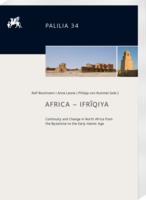|
|
more titles of the subject:
Download:
‹Africa – Ifrīqiya› is dedicated to the study of the transformational period that marked the end of Antiquity in the southern Mediterranean: the transition between east Roman, or Byzantine, and Arabic (and ultimately Islamic) rule over what eventually came to be known as the Maghreb, the former territory of Roman North Africa. It brings together current research by internationally renowned experts from Europe, North Africa, Australia, and the USA who have contributed important work in recent years to the study of this period.
The sections in this book cover historical questions, the fields of religion and ur-banism, and developments in landscapes and the economy. A wide range of topics is discussed, including church building, the founding of early mosques, military history, and the ideology of political centres. A number of articles feature detailed presenta-tions and discussions of Arabic sources. Many of the contributions present recent archaeological research, making material evidence available for the post-Roman phases in a number of exemplary sites such as Carthage, Kairouan, Ammaedara, and Chimtou. Settlement topography and economic developments are analysed from broad perspectives, while regional studies focus on particular areas like the Tunisian Sahel and Tripolitania. Works on early Islamic coinage and pottery provide valuable information on the material culture of the transitional period. Uniting interdisciplinary research and presenting new perspectives on the fasci-nating period between Antiquity and the early Islamic world, this volume furthers our understanding of how the transitional process played out on the ground in North Africa. Its contributions help to illuminate how (post-)Roman Africa slowly trans-formed into a new world of changing communities, diversified religious affiliations and new connections across the Mediterranean. |






